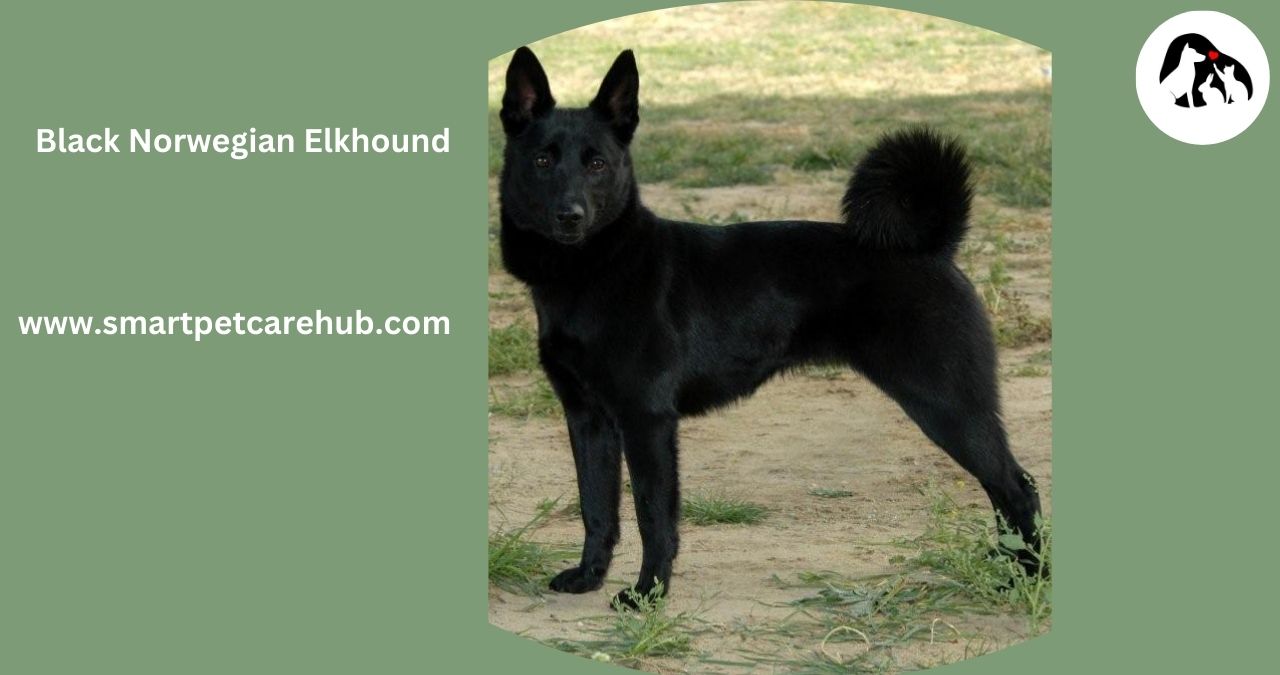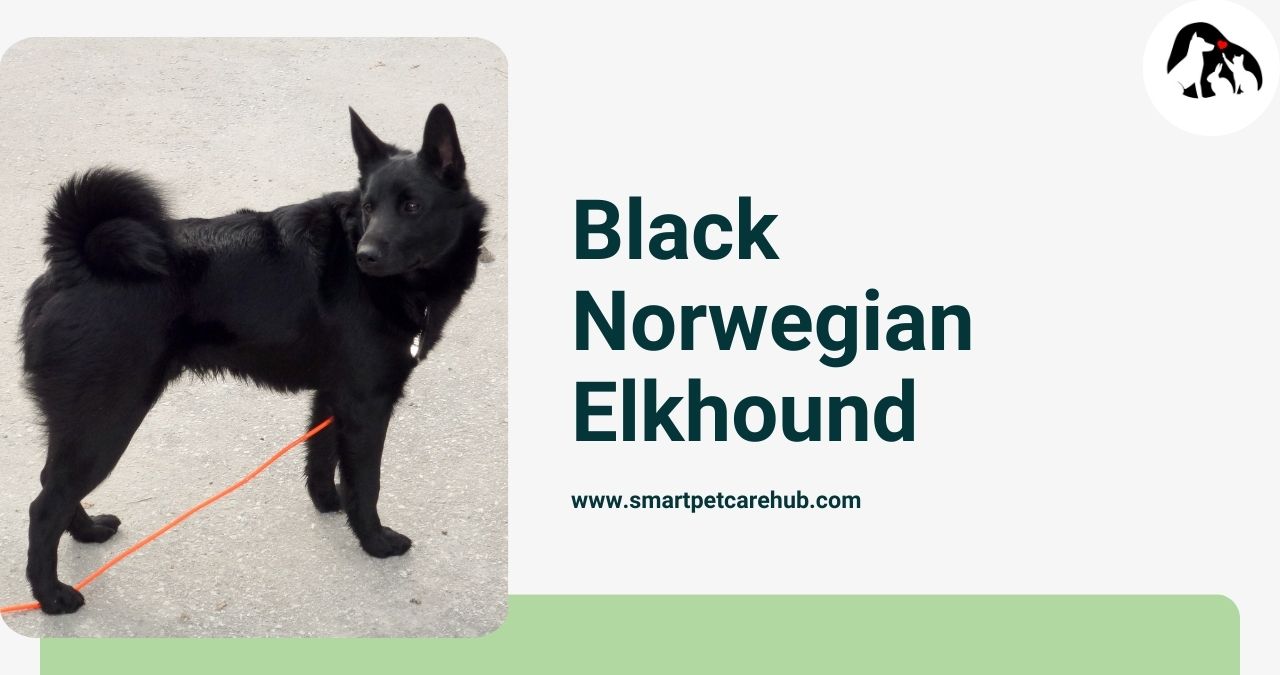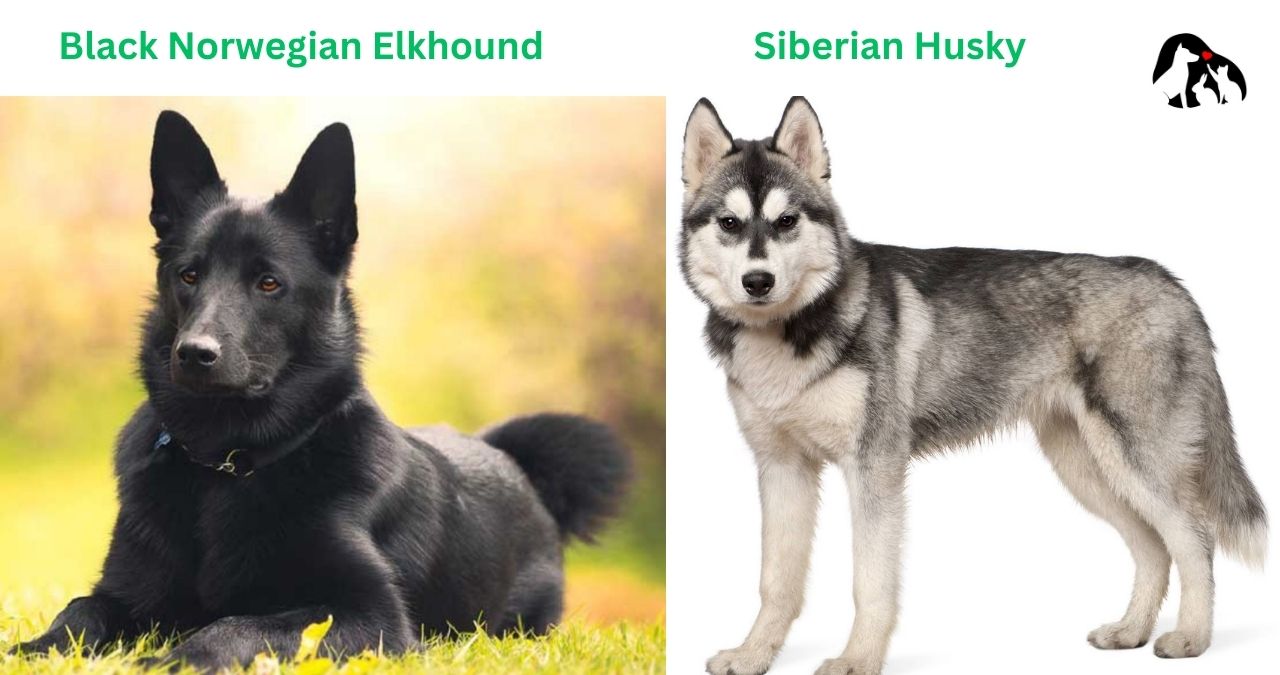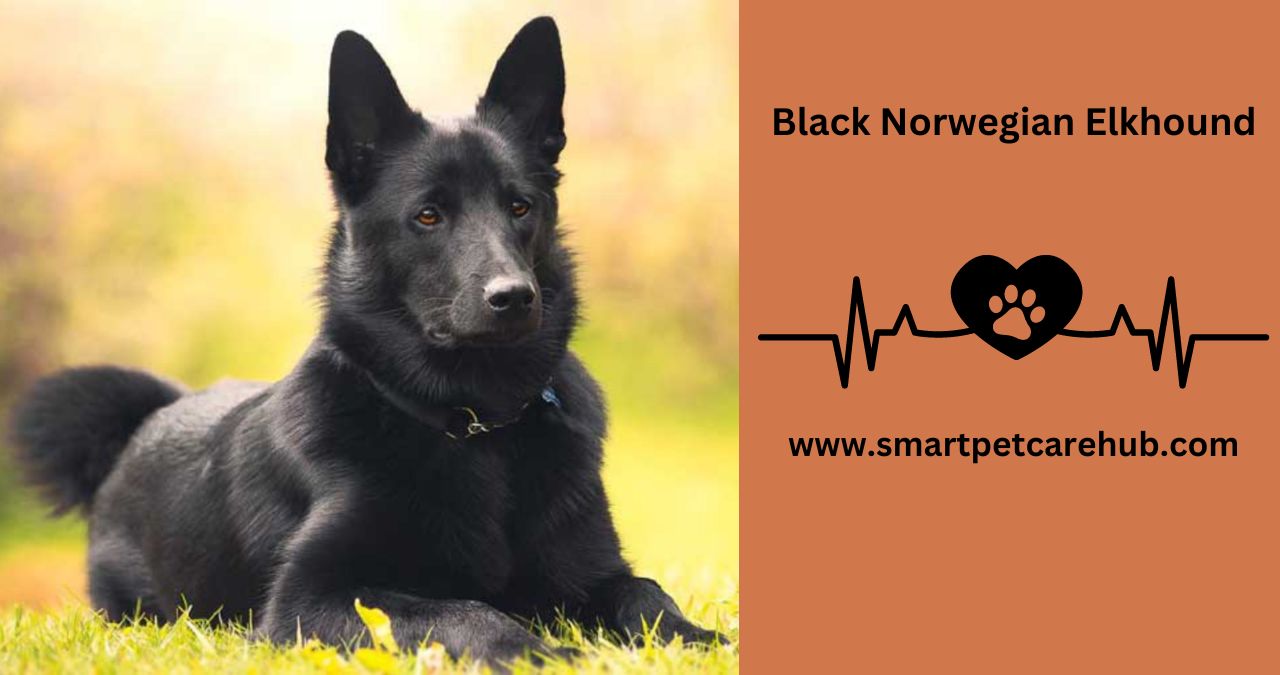Identification of the Black Norwegian Elkhound
Black Norwegian Elkhound is a robust, versatile hunting dog known for its strength, endurance, and attractive appearance. Below is a detailed identification of this breed based on its physical characteristics:
Size : The Black Norwegian Elkhound is a medium-sized dog, typically standing about 17 to 20.5 inches (43 to 52 cm) tall at the shoulder. Males are typically larger, weighing between 45 and 55 pounds (20 to 25 kg), while females are slightly smaller and lighter. Despite its compact size, the breed is robust and strong, with a muscular body for endurance during long hunts.
Color : As its name suggests, the Black Norwegian Elkhound is primarily black in color. The coat is typically a solid black, although slight lighter shades may appear on the chest or underbelly. The uniform black coat gives the dog a sleek, striking appearance that helps it blend into its surroundings while hunting in Norway’s dense forests. The color further accentuates its regal and bold look, making it stand out from other hunting dogs.
Coat : The Black Norwegian Elkhound has a double coat that is dense and weather-resistant. The outer coat is short, coarse, and thick, while the undercoat is soft and woolly, providing insulation in cold weather. This double coat protects the dog from harsh weather conditions, allowing it to work in rugged terrain without discomfort. The coat requires little maintenance in terms of cleaning, but it sheds a lot, especially during seasonal changes.
Eyes : The eyes of this breed are one of its most expressive features. They are medium-sized, oval-shaped, and usually dark brown in color. The eyes convey a sense of intelligence, alertness, and focus. As a hunting dog, the Black Norwegian Elkhound’s keen eyesight is vital for tracking and identifying prey at long distances. The eyes are also a window into the dog’s loyal and calm nature, which complements its powerful build.
Head : The Black Norwegian Elkhound’s head is broad and wedge-shaped, with a slightly domed skull. The muzzle is strong, moderately short, and slightly tapered toward the nose, giving the dog a balanced, proportionate appearance. The head is well-defined and noble, reflecting the breed’s alert and dignified demeanor. Its facial features are designed for both strength and precision, making it highly effective as a hunting companion.
Ears : This breed has medium-sized, erect ears that are set high on the head. The ears are triangular in shape and slightly rounded at the ends. Their erect and forward-facing nature helps the Black Norwegian Elkhound to be constantly alert to its surroundings and hear sounds coming from great distances. The ears, along with the dog’s overall keen senses, contribute to its hunting skills and quick reactions.
Mouth : The Black Norwegian Elkhound’s mouth is equipped with strong jaws and a powerful scissor bite. The lips are firm and clean, without any droop, which adds to the breed’s sharp and refined expression. Its bite is vital for catching prey, making it an effective hunting dog. Its teeth are large and well-spaced, designed for catching and holding large prey, which this breed traditionally hunted in its native Norway.
Legs : The Black Norwegian Elkhound’s legs are strong and straight, built for endurance and speed. The front legs are sturdy and well-muscled, while the hind legs are powerful and their joints are well-angled giving the dog impressive speed when running or walking across uneven terrain. These characteristics enable this breed to travel long distances without tiring, which is a must for dogs bred to hunt in challenging landscapes.
Tail : The Black Norwegian Elkhound’s tail is a defining feature. It is tightly curled over the back, a trait common in Spitz-type breeds. The tail is covered in dense fur and enhances the breed’s balanced, symmetrical look. The curled tail is not only an aesthetic feature, but also helps with balance and agility when the dog runs or quickly changes direction while hunting.
Paws : The Black Norwegian Elkhound’s paws are compact and round, with thick pads that provide protection and grip in rough terrain. Well-arched claws and strong pads help the dog move easily across rocky, snowy, or wooded terrain. The paws are built for stamina, helping the dog track prey over long distances without experiencing discomfort or injury.
bite force : Estimates of cutting force range from 200 to 300 PSI (pounds per square inch).
average speed : The average speed of the Black Norwegian Elkhound is about 30 to 35 miles per hour (48 to 56 kilometers per hour).
average life : The average lifespan of the Black Norwegian Elkhound is usually between 12 and 15 years.

Birth place of the Black Norwegian Elkhound
The Black Norwegian Elkhound comes from Norway. This breed was developed in the rugged areas of Norway, where it was primarily used for hunting large animals such as elk and moose. The history of this breed is deeply rooted in Scandinavian culture, and it has been a faithful companion of hunters in Norway for centuries.
Other name of the Black Norwegian Elkhound
The Black Norwegian Elkhound is also sometimes known by the following alternate names:
Norwegian Moose Dog (Black) – This name highlights the breed’s hunting origins, specifically in tracking and hunting moose in Norway.
Sorte Norsk Elghund – This is the breed’s name in Norwegian, with a direct translation of “Black Norwegian Elkhound.”
These names emphasize the breed’s heritage as a hunting dog and its Norwegian origins.
Exercise of the Black Norwegian Elkhound
The Black Norwegian Elkhound is a highly energetic and active breed, originally developed for hunting large prey such as elk and moose in the rugged terrain of Scandinavia. As a result, this breed requires significant physical and mental exercise to stay healthy and happy. Here is a detailed description of their exercise requirements:
Daily Physical Exercise : The Black Norwegian Elkhound needs at least 1 to 2 hours of exercise every day. This can be divided into multiple walks, playtime, and other activities. Given their background as hunting dogs, they excel at high-energy activities and enjoy tasks that challenge them physically.
Long Walks or Hikes : Because of their stamina and strength, Elkhounds benefit from long walks or hikes, especially in natural environments. They thrive in outdoor activities where they can explore and use their natural instincts. A 4 to 6 mile (6.5 to 10 kilometer) walk several times a week is ideal for keeping their energy levels up.
Off-leash running : Black Norwegian Elkhounds are happiest when they have the opportunity to run freely in open spaces. If you have a securely fenced area or dog park, giving them the opportunity to run, chase and play off-leash will help them expend excess energy. They are fast and agile, so this type of activity is good for them.
Mental stimulation : In addition to physical exercise, mental stimulation is also important. Black Norwegian Elkhounds are intelligent dogs that need problem-solving tasks to keep their minds active. Engaging them in activities such as puzzle toys, interactive games or obedience training helps prevent boredom, which can lead to destructive behavior.
Agility and obedience training : These dogs excel at agility and obedience training, which provides both mental and physical exercise. Agility courses with jumps, tunnels and weaving poles are a great way to challenge them. Regular training sessions also strengthen the bond between dog and owner as well as keep their minds sharp.
Hunting and Tracking Sports : Given their hunting background, Black Norwegian Elkhounds have a strong hunting instinct and enjoy activities such as hunting or tracking. Scent work, tracking exercises or games of hide and seek can satisfy this instinct. Engaging them in these activities helps them use their natural abilities and keeps their focus.
Playtime with Other Dogs : Black Norwegian Elkhounds are generally social and enjoy the company of other dogs. Playing with other active dogs can be a great way for them to get extra exercise. Playdates or going to the dog park give them a chance to interact, run and play in a more dynamic setting.
Structured Exercise Routine : Establishing a structured exercise routine helps keep Elkhounds well-behaved and mentally stable. Breaking up their day with regular exercise sessions ensures that they stay content and are less likely to develop behavioral problems like excessive barking or digging, which can happen if they are under-stimulated.
Variety in Exercise : Black Norwegian Elkhounds benefit from a variety of exercises, as doing the same type of activity day after day can lead to boredom. Mixing up activities like jogging, swimming, hiking or even playing fetch keeps them engaged and excited about exercise. They are naturally adventurous dogs and love exploring new environments.
Cold Weather Activities : Elkhounds are made for cold weather, with their thick double coats providing insulation. They thrive in winter activities, and cold weather does not hinder their exercise needs. Engaging them in activities like hiking on snow or pulling small sleds can be great forms of winter exercise.

Grooming of the Black Norwegian Elkhound
Grooming the Black Norwegian Elkhound is important to maintain its health and appearance, especially given its thick coat and active nature. Below are details on grooming different aspects of the breed.
Coat Care : The Black Norwegian Elkhound has a dense and double coat that requires regular attention. The outer coat is coarse and weather-resistant, while the undercoat is soft and insulating. To keep the coat healthy and tangle-free, brush the coat 2 to 3 times a week using a slicker brush or undercoat rake, especially during the shedding season in spring and fall. Regular brushing helps reduce tangles, remove loose hair, and promote good skin health by stimulating blood circulation.
Bathing : This breed does not require frequent bathing, as excessive bathing can strip the natural oils from the coat, leading to dry skin. Bathe the Black Norwegian Elkhound every 8 to 12 weeks or when it becomes very dirty from outdoor activities. Use a gentle, dog-safe shampoo to clean the coat without irritating the skin. After bathing, make sure the dog is rinsed and dried thoroughly, especially since moisture trapped in the dense undercoat can cause skin problems such as hot spots.
Ear Cleaning : The Black Norwegian Elkhound’s upright ears are prone to accumulating dirt, especially after outdoor activities. Clean the ears once a week using a veterinarian-approved ear cleaning solution to prevent infection. Use a cotton ball to gently wipe the outer ear canal, making sure you don’t insert it too deeply, which can damage the ear. Regular ear checks can help you detect early signs of infection, such as redness, foul odor or excessive itching.
Eye Care : The breed’s dark, expressive eyes should be checked regularly for any signs of irritation, discharge, or redness. Use a soft cloth or cotton pad soaked in warm water to gently clean around the eyes, removing any debris or secretions. This is especially important if the dog has been in a dusty or windy environment. Regular eye cleaning helps prevent infection and keeps the eyes clean and healthy.
Dental Hygiene : Good dental care is essential to the Black Norwegian Elkhound’s overall health. Brush the dog’s teeth 2 to 3 times a week with a dog-specific toothbrush and toothpaste to prevent tartar buildup and gum disease. You can also provide dental chews and toys designed to clean the teeth while the dog chews. Regular dental checkups from the vet will help keep the teeth and gums healthy, preventing serious dental problems in the future.
Skin Exam : When brushing, it is important to examine the skin to check for any signs of irritation, parasites or unusual lumps. The Black Norwegian Elkhound’s thick coat can hide skin problems, so run your hands carefully over the dog’s body, especially in places where mats or dirt may accumulate, such as behind the ears, under the legs and around the neck. Early detection of skin problems can prevent more serious health concerns later on.
Tail Care : The breed’s curved tail is covered in dense fur and should be brushed regularly to prevent tangling and knotting. The tail is often overlooked during grooming, but regular attention ensures that it stays clean and free of debris. The tail should be brushed at the same time as the rest of the coat, at least 2 to 3 times a week. Additionally, check for any signs of injury or irritation on the tail, especially if the dog has been in a harsh outdoor environment.
Nail Trimming and Claw Care : Nail trimming is necessary to prevent the nails from overgrowing, which can cause discomfort or affect the dog’s gait. Trim nails every 3 to 4 weeks using dog nail clippers, making sure not to cut too close to the nail. If you’re unsure, a professional groomer can help. In addition to trimming, check the dog’s paws regularly for cuts, cracks or debris, especially after outdoor activities. Applying a balm to the paws keeps the pads soft and can prevent cracking in dry or cold conditions.
Anal Gland Expression : Like many dogs, the Black Norwegian Elkhound may occasionally need anal gland expression, especially if the glands are impacted. Symptoms of glandular problems include scooting, excessive licking or foul odor. Some dogs express their glands naturally, but others may need the help of a groomer or veterinarian. Expressing the glands regularly prevents discomfort and possible infection, keeping the dog healthy and happy.
Cleaning the genital area : Keeping the genital area clean is essential to dog hygiene, especially after playing outside or going to the bathroom. Use a damp cloth to gently wipe the area as needed, making sure it stays clean and free of irritation. Female dogs, in particular, may need more attention during their heat cycle. Keeping the genital area clean prevents infection, irritation, and discomfort, promoting the dog’s overall health and hygiene.
Common Health Problems of the Black Norwegian Elkhound
The Black Norwegian Elkhound, like many purebred dogs, can be prone to certain health problems due to genetic factors and breed-specific traits. Despite being a generally robust and healthy breed, it is important to be aware of the common health problems that affect this breed. Some of the most common health problems seen in the Black Norwegian Elkhound are as follows:
Hip Dysplasia : Hip dysplasia is a genetic condition in which the hip joint does not fit properly into the hip socket, causing pain, lameness, and arthritis. Black Norwegian Elkhounds are prone to hip dysplasia, which can result in decreased mobility and discomfort, especially as they age. Regular veterinary checkups, weight management, and surgery in severe cases, can help manage this condition.
Progressive Retinal Atrophy (PRA) : PRA is an eye disease that affects the photoreceptor cells in the dog’s retina, leading to gradual vision loss and eventual blindness. This condition is hereditary and cannot be treated, although it can be detected early through an eye exam. Responsible breeders often test for PRA to reduce the risk of passing it on to future generations.
Hypothyroidism : Hypothyroidism is a condition in which the thyroid gland does not produce enough hormones, leading to symptoms such as weight gain, lethargy, hair loss, and skin problems. Black Norwegian Elkhounds are susceptible to this condition, and it is usually managed with daily medication and regular monitoring by a veterinarian.
Elbow dysplasia : Similar to hip dysplasia, elbow dysplasia is a condition that affects the elbow joint, causing pain and lameness. This is another hereditary condition that can cause arthritis and reduced mobility, especially in older dogs. It can be managed with weight control, anti-inflammatory medications, and in some cases, surgery.
Bloat (Gastric Dilatation-Volvulus) : Bloat is a life-threatening condition in which the stomach fills with gas and can twist, cutting off the blood supply and causing severe pain. Large, deep-chested breeds like the Black Norwegian Elkhound are at a higher risk of bloating. Symptoms include restlessness, bloated abdomen, excessive salivation, and attempts to vomit. Emergency veterinary treatment is needed to save the dog’s life.
Patellar Luxation : Patellar luxation occurs when the knee cap slips out of place, causing pain and lameness. In mild cases, it may only cause occasional discomfort, but severe cases may require surgery. This condition is more common in smaller dogs, but can also affect medium-sized breeds like the Black Norwegian Elkhound.
Ear Infections : Because of their upright ears and active lifestyle, Black Norwegian Elkhounds can be prone to ear infections, especially if they spend a lot of time outside in wet or dirty environments. Regular ear cleaning and inspections can help prevent infections and keep their ears healthy.
Obesity : While not a specific disease, obesity can exacerbate a number of health problems, including joint problems, heart disease, and diabetes. Black Norwegian Elkhounds have a tendency to gain weight if not exercised enough or fed an improper diet. Maintaining a healthy weight through proper diet and regular exercise is important to avoid obesity-related problems.
Allergies : Elkhounds can suffer from allergies, which can manifest as skin irritation, excessive scratching, ear infections, or gastrointestinal problems. Allergies can be caused by environmental factors (such as pollen or dust), food ingredients, or flea bites. Managing allergies often involves identifying and avoiding triggers, administering medication, or adjusting the dog’s diet.
Glaucoma : Glaucoma is an eye condition that results in increased pressure inside the eye, which can lead to pain, vision loss, and potentially blindness if left untreated. Elkhounds can be prone to this condition, and early detection is vital to manage the disease and prevent serious damage to the eye.

Popular Black Norwegian Elkhound Mixed Breeds
The Black Norwegian Elkhound is a versatile and strong breed, and it has been mixed with many other breeds to create unique and popular hybrids. These mixed breeds often inherit the intelligence, agility, and loyalty of the Elkhound. Here are some popular Black Norwegian Elkhound mixed breeds:
Elkhound Lab (Elkhound x Labrador Retriever) : The Elkhound Lab is a mix of the Black Norwegian Elkhound and the Labrador Retriever. This combination produces a highly energetic, friendly, and loyal dog that is great for families. They inherit the hunting instincts of the Elkhound as well as the Labrador’s love of play and companionship.
Elkhound Shepherd (Elkhound x German Shepherd) : The Elkhound Shepherd blends the stamina of the Elkhound and the intelligence and trainability of the German Shepherd. This hybrid is known for being a strong, protective dog, suitable for families and working environments. They often excel in roles such as search-and-rescue, guard duty, and even herding.
Elk-Akita (Elkhound x Akita) : The Elkhound-Akita is a mix of the Black Norwegian Elkhound and the Akita, resulting in a large and powerful dog with strong guarding instincts. This hybrid is often loyal and protective, making them excellent watchdogs and family guardians. They are also quite independent and require a firm hand in training.
Elkhound Husky (Elkhound x Siberian Husky) : The Elkhound Husky is an energetic, athletic dog that combines the hunting instincts of the Elkhound with the Siberian Husky’s stamina and love of adventure. This mix is highly active, requiring plenty of exercise and mental stimulation. They do well in cold climates and make excellent companions for outdoor enthusiasts.
Elkhound Collie (Elkhound x Border Collie) : The Elkhound Collie is a mix of the hunting ability of the Elkhound and the herding instincts of the Border Collie. This combination results in a highly intelligent, active dog that requires a lot of mental and physical exercise. They excel at agility, obedience training, and herding tasks.
Elkhound Poodle (Elkhound x Poodle) : The Elkhound Poodle mix combines the intelligence and hypoallergenic qualities of the Poodle with the hardiness of the Elkhound. This hybrid is an intelligent, energetic dog that is often easier to groom than a purebred Elkhound, thanks to the Poodle’s coat. They are often friendly and make good family pets.
Elkhound Rottweiler (Elkhound x Rottweiler) : The Elkhound Rottweiler is a strong, confident dog that inherits the protective nature of the Rottweiler and the stamina of the Elkhound. This mix is large and powerful, making it a good choice for experienced dog owners who want a loyal and protective companion.
Elkhound Golden (Elkhound x Golden Retriever) : The Elkhound Golden combines the friendly, loving nature of the Golden Retriever with the intelligence and hunting instincts of the Elkhound. This hybrid is often gentle, affectionate, and good with children, making it a great family dog. They are also active and enjoy outdoor activities.
Elkhound Malamute (Elkhound x Alaskan Malamute) : The Elkhound Malamute mix makes a large, powerful dog with a strong prey drive and a love for outdoor activities. This hybrid is highly energetic, making them suitable for families or individuals who enjoy hiking, running, or other outdoor activities. They do well in cold weather due to their thick coat.
Elkhound Boxer (Elkhound x Boxer) : The Elkhound Boxer is a playful and active dog that combines the hunting instincts of the Elkhound with the energetic and fun-loving nature of the Boxer. This hybrid is usually medium to large in size, with a muscular body, and they love spending time with their family. They require a lot of exercise and are great for active homes.


Leave a Reply
You must be logged in to post a comment.